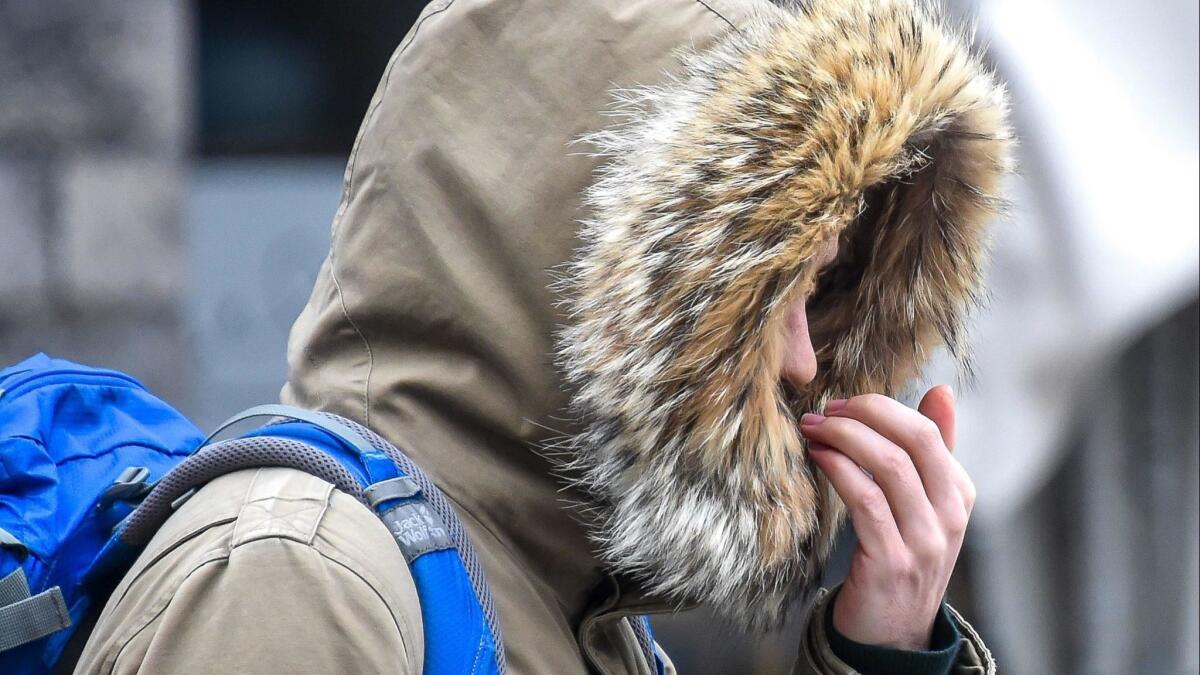Can you skip your regular workout and just shiver instead?

- Share via
What do shivering and exercise have in common?
More than you might think.
Both shivering and exercise cause you to contract your muscles and expend energy — that’s pretty obvious.
But less obvious is a new discovery, published Tuesday in Cell Metabolism, that they both release a molecule into the bloodstream that tells your muscles to start burning fat.
So, does that mean you can skip your Zumba class and sit in a cold bath instead?
“That’s not a crazy thing at all,” said Laurie Goodyear, a physiologist at the Joslin Diabetes Center at Harvard University, who worked on the new study.
But you may want to consider the consequences.
“The problem with cold exposure is that most people can’t tolerate it,” Goodyear said. “It’s hard to sit in a bathtub full of ice cubes.”
We all know that exercise is good for our health, but Goodyear’s lab is interested in discovering how those benefits play out on a molecular level.
“Exercise is one of the best preventative medicines, and it can help in the treatment of so many diseases,” she said. “We are trying to understand how that happens.”
In this latest research, Goodyear and her collaborators wanted to see what role a relatively understudied type of molecule called a lipokine might play in exercise pathways.
Lipokines are lipids that circulate in the blood and act as signals to tissues.
Just last year, Goodyear’s colleague and co-author Kristin Stanford, a physiologist at the Ohio State University College of Medicine, had published work that found that shivering caused a lipokine named 12,13-diHOME to increase in the bloodstream of chilly people.
She also discovered that this lipokine was produced by brown fat, a type of healthy fat that resides just behind the neck and near the shoulder blades in adults.
This wasn’t so shocking. Brown fat is known to be involved in temperature regulation — specifically in keeping people warm.
Cells in brown fat have an abundance of mitochondria, the powerhouse of the cellular machinery. When brown fat is active, the mitochondria go to work and generate heat. This warms the blood as it circulates.
It seems logical enough that a system that already is activated when a person gets cold also might produce molecules that tell shivering muscles to start taking up fat to use for energy.
But the scientists were really surprised when they screened the blood of 27 healthy men before and after exercise and found that the same lipokine released when people shiver is also released when they work out.
After all, we get warm when we exercise so an internal heater shouldn’t be necessary.
“It was very unexpected,” Goodyear said. “We really did not think that the same lipokine that was stimulated by cold would be stimulated by exercise.”
And this surprise had advantages.
Thanks to Stanford’s previous work, the research team already knew that brown fat produces the lipokine 12,13-diHOME during shivering. This led them to wonder whether it was also responsible for producing the same lipokine during exercise.
To find that out, they removed brown fat from mice and put them in an exercise cage. Next, the researchers tested their blood to determine whether the amount of circulating 12,13-diHOME had gone up. (It didn’t).
“This was very interesting to us,” Goodyear said. “We had been under the impression that brown fat didn’t do much during exercise, but we now know it is secreting this lipokine.”
As is often the case in science, the answer to one question has led to a whole series of new questions.
Goodyear said the team’s next line of inquiry is to determine what is telling the brown fat to release the lipokine during exercise. Is it the muscles? The brain? Perhaps the nervous system?
Another question she’d like to see addressed is whether exercising in the cold would be a more effective way to burn calories for those who are willing to put with the discomfort.
There is also a question about what other effects this lipokine has one the body beyond the beneficial effect of causing the muscles to break down fat.
“Lipokines could be a potential target for drug therapy if we can make a drug that mimics some of the effects of exercise,” she said.
Do you love science? I do! Follow me @DeborahNetburn and “like” Los Angeles Times Science & Health on Facebook.
MORE IN SCIENCE
These five healthy habits could extend your life by a dozen years or more, study says
The shape, not size, of our ancestors’ brains may have helped them outlast Neanderthals
Here’s why the apparent increase in autism spectrum disorders may be good for U.S. children




